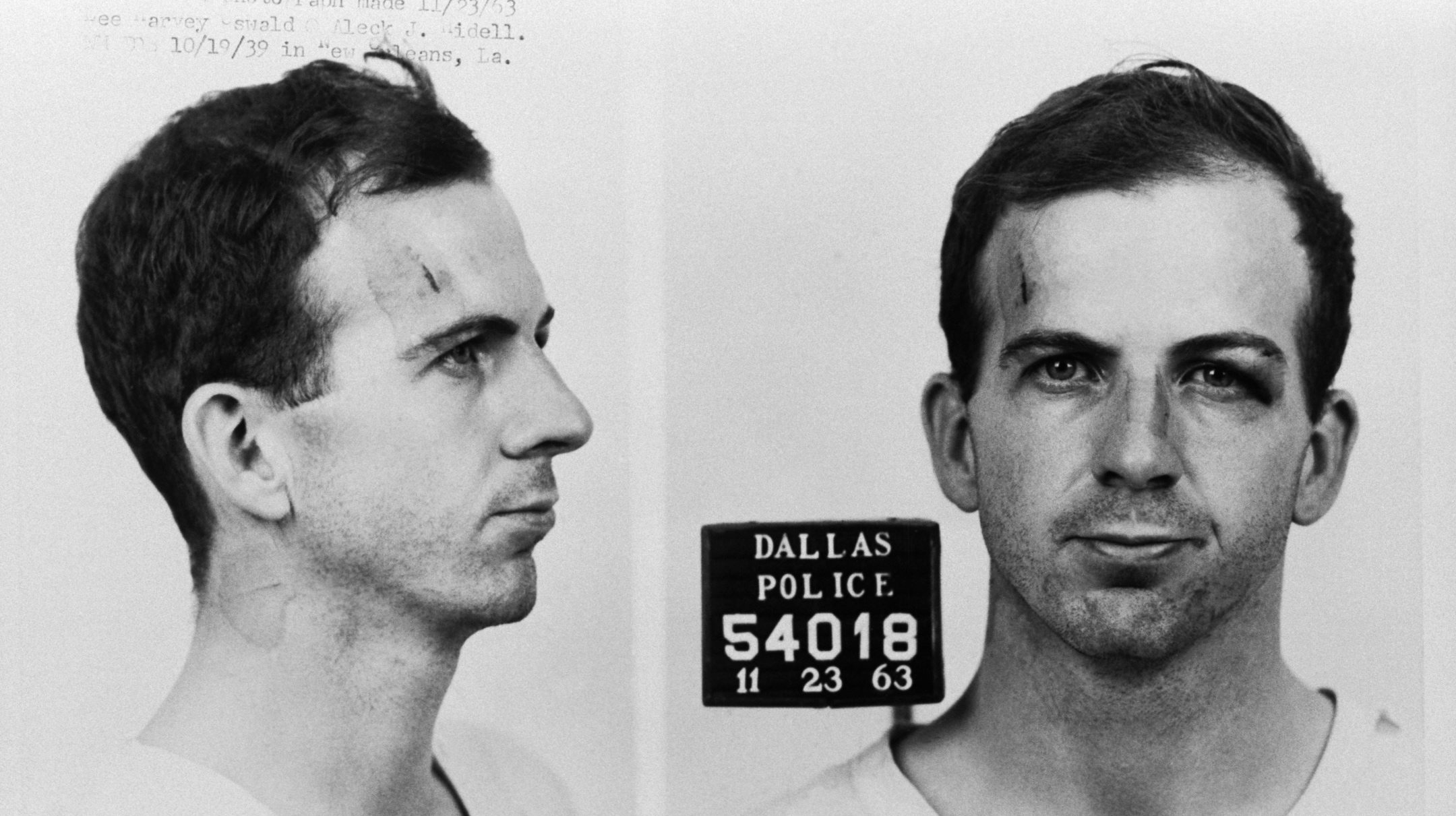JFK documents reveal assassin’s CIA monitor was Reuben Efron, a Jewish spy who loved Midrash
The spy who opened Lee Harvey Oswald’s mail had a thing for his own biblical counterparts

The Dallas Police Department mug shots of Lee Harvey Oswald following his arrest for possible involvement in the John F Kennedy assassination and the murder of Officer JD Tippit. (Corbis via Getty Images)
(JTA) — For decades, armchair analysts scrutinizing the mysteries of the President John F. Kennedy assassination have fixated on who, exactly, opened his future assassin’s mail while he was under CIA surveillance.
As the conspiracy theory went, that person would have understood Lee Harvey Oswald’s relationship with the Soviet Union and thus could unlock new information about a possible Communist plot against Kennedy — or a U.S. government plot to obscure his true killer.
Last month, a new document dump in the ongoing declassification of Kennedy documents revealed the identity of the CIA screener: one Reuben Efron, a lieutenant colonel in the U.S. Army and a Jewish immigrant from Lithuania.
The New York Times was the first to report Efron’s identity. “And that means — what, exactly?” the newspaper asked in its report. “A tantalizing clue to unraveling a complicated conspiracy that the government has sought to cover up for decades? Additional proof that the C.I.A. knew more about Oswald than initially acknowledged? Or a minor detail withheld all this time because of bureaucratic imperatives irrelevant to the question of whether Oswald was the lone gunman on the fateful day?”
A deep dive into Efron’s Jewish identity does not answer those questions. But it does reveal that Efron not only worked as a spy but had a deep knowledge of the spies in Jewish tradition.
The Jewish Telegraphic Agency has confirmed that Efron spent time living in Israel before dying on Nov. 22, 1993 — 30 years to the day after Kennedy’s assassination. While there, he contributed five articles in the 1970s to the Jewish Bible Quarterly, a World Zionist Organization-affiliated publication based in Jerusalem, that channeled his expertise in espionage.
“Rahab and her premises were under surveillance of a counterintelligence team of the king of Jericho who soon established that the two men visiting Rahab were actually Israelite spies,” he writes in one of the essays, referring to a Jericho courtesan who, according to the Book of Joshua, assisted the Israelites in preparing to rout the Canaanites. Efron called Rahab “a prototype of a Mata Hari,” the World War I-era exotic dancer-turned-spy.
In one of the essays, Efron directly addresses the problem of spies incorrectly assessing their surveillance target — a critique that has been leveled about his read of Oswald. About the 10 spies who, in the Book of Numbers, returned to the Israelites unsettled by their venture into Canaan, he writes, “The militarily inexperienced scouts apparently had been unduly impressed with the prowess of the enemy and, as is frequent among Easterners, exaggerated his capabilities.”
The essays, three of which appeared in a series called “Military Intelligence in the Bible,” do little to illuminate either the Kennedy assassination or the inner life of the man who read Oswald’s mail. But they do shed light on how he spent his retirement.
Efron was born Ruvelis Effronas in Simnas, Lithuania, on April 12, 1911, and attended a Jewish high school there (a “Hebrew gymnasium,” in his words), followed by Vytautas Magnus University in what is now Kaunas. He practiced law for five years in that city — a thriving hub of Lithuanian Jewish life that would become the site of the country’s largest ghetto under the Nazis — before emigrating, as his brother had done previously.
Efron immigrated to the United States in December 1939, arriving in Miami via Cuba. U.S. immigration documents list his profession as a salesman. According to a family history compiled by a relative, the following fall he enrolled at the Atlanta Law School, a night school that closed in the 1990s. He worked at a clothing store in downtown Atlanta until graduating in 1943.
He spoke Russian, Lithuanian, Hebrew, Yiddish and German and enlisted in the Air Force during World War II as an interpreter, according to a death notice published in the Miami Herald. After the war, the death notice said, he played a role in peace negotiations and in talks related to the resettlement of war refugees — among them, perhaps, members of his own family, but not his mother, who according to the published genealogy was murdered in the Holocaust.
For decades, Efron worked for the U.S. government, playing roles that are only now coming to light as secret government documents are made available to the public. His family history says only: “Reuben worked for the Pentagon.”
In addition to his now-revealed role reading Oswald’s mail, Efron pops up in another declassified document dealing with an area of amateur sleuthing that has garnered a following as intense, if not more so, than the Kennedy assassination.
In October 1955, Efron was traveling by train in the Soviet Union with U.S. Sen. Richard Russell, a Georgia Democrat, and a senior U.S. army official. The three men reported seeing two “circular and unconventional aircraft resembling flying discs or flying saucers … taking off almost vertically one minute apart.”
“After sighting, Soviet train men became excited and lowered curtains and refused permission to look out windows,” says the 1955 report, declassified in 2004. “U.S. observers firmly believe these unconventional aircraft are flying saucer or disc aircraft.”
In retirement, Efron apparently enjoyed the freedom to opine. Living in Washington, D.C., in 1971, he wrote to the New York Times urging the Nixon administration to reject proposals of a joint U.S.-Soviet force to police Egypt-Israel peace, saying it would ”communize the whole area.”
It’s not clear if he ever officially immigrated to Israel using its Law of Return, which grants automatic citizenship to Jews who move to the country. But the obituary in the Miami Herald said that Efron “commuted between Israel and the United States for many years, during which he studied Israeli law and was admitted to the Israeli bar.” The obituary said Efron was inspired by his mother’s work in Lithuania with Jews who were immigrating to Palestine.
In 1982, Efron lived on Keren Hayesod street in Jerusalem bordering the neighborhood of Rehavia, genealogical records show. Rehavia, now a neighborhood bursting with ostentatious wealth, much of it American, was then a leafy and somewhat decayed enclave of aging “yekkes,” or German Jews, many of them from the university-educated class that had fled the Nazis, arriving in Palestine in the 1930s.
The address would have been a pleasant 10-minute walk from the offices of the Jewish Bible Quarterly.
A staffer at the quarterly checked with surviving retired staff who worked during the late 1970s; no one could recall working with Efron. But his contributions to the quarterly are mostly preserved: JTA was able to locate three of the five essays.
In them, Efron comes across as an enthusiast of the ancients with a fundamentalist’s belief in the Bible as relaying an accurate historical narrative.
“The Bible relates truthfully David’s charismatic personality, physical charm, as well as frailties and ethical shortcomings,” Efron writes, reviewing the clandestine means David and Jonathan employed in the Book of Samuel to determine whether Jonathan’s father, Saul, planned to assassinate David.
As befits someone writing for a World Zionist Organization publication, Efron draws parallels between ancient and modern Israel, and finds much to praise in both national expressions.
“It should be noted that in ancient as well as in recent times the people of Israel adhered to their promises and covenants with their neighbors,” he writes in describing Joshua’s sticking to his pledge to protect the Gibeonites despite their deception, the spycraft that is the article’s focus.
Efron deploys accounts of Israel’s modern spycraft to establish a continuum between biblical times and the 20th century.
“A recent example of such a secret encounter in Israel’s international relations is the now well publicized, but at that time very guarded meeting between the former Foreign Minister, Moshe Dayan, with the then Egyptian Deputy Prime Minister, Muhammed Hassan al-Tohami, in September 1977, in Morocco, which laid the groundwork for Egyptian President Sadat’s historic visit to Jerusalem,” he writes in the article about David and Jonathan.
Details about Efron’s identity and background exercised the community of JFK assassination theorists to a much lesser degree than the fact that a senior CIA official was tracking Oswald — and the tantalizing prospect that there was more to learn.
“The memo shows that high-level CIA officers were interested in the smallest details of Oswald’s life 17 months before Kennedy was killed,” Jefferson Morley, an author of multiple books about the CIA, and about Kennedy, said on his blog, JFK Facts, after the revelation. “If Oswald was the ‘lone gunman,’ as a substantial minority of Americans believe, the clandestine service had much more access to his personal information than most know.”
Efron had a wife, Edna, a brother, Irving, and no children. Said the death notice in the Miami Herald: “He was a most diligent and modest person.”
This article originally appeared on JTA.org.
A message from our Publisher & CEO Rachel Fishman Feddersen

I hope you appreciated this article. Before you go, I’d like to ask you to please support the Forward’s award-winning, nonprofit journalism during this critical time.
We’ve set a goal to raise $260,000 by December 31. That’s an ambitious goal, but one that will give us the resources we need to invest in the high quality news, opinion, analysis and cultural coverage that isn’t available anywhere else.
If you feel inspired to make an impact, now is the time to give something back. Join us as a member at your most generous level.
— Rachel Fishman Feddersen, Publisher and CEO























